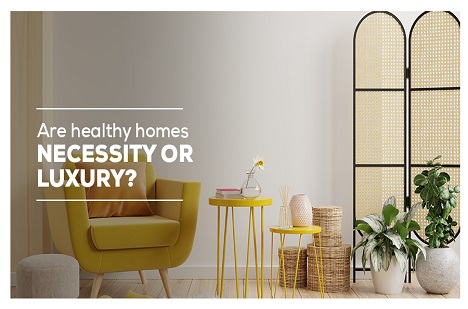To witness a change is more difficult when you have to inherit into your livelihood. The mode of making resources more adaptable and plentiful by using the changs into a more efficient, sufficient, and adaptable substitute. As individuals are valuing more on health and wellness than on materialistic objects these days in terms of a home, the distinction of necessity and luxury has evolved.
In an era in which many catalogs their health-conscious state on social media by looking great with an intake of a healthy diet, feeling good, and sleeping well pursuing a healthy lifestyle. But transforming one’s home into a healthy home – is it a necessity or a luxury? Whichever side you assert the view towards health in the current real estate market. The juxtaposition of a healthy home being a necessity or a luxury is a tranquilizing question leading to intertwining answers.
What are Healthy Homes?
Our home, locale, and the physical building itself influences an important aspect of our lives – from how well we sleep, to how safe and secure we feel. If we are to improve the health and wellbeing of individuals, families, and communities, there can hardly be a more important place to start than one’s home. Living in a Healthy Home is a more holistic state of being, where one’s mental, physical, and emotional health are in sync. Apart from the harmony, it endures the benefits of living in a sustainable residential property? Is that even a possibility?
The entire real estate sector is moving towards a dynamic and challenging change towards enhancing the lives of the people they design and build for. The acceptance of a healthy home is one of the emerging trends that the developers need to match up with. In today’s market trend, a customer-savvy developer must understand homebuyer’s quality living and take action on the growing needs of the community. Needs such as good daylight levels, good ventilation leading to reduced energy consumption and carbon emissions, or the provision of open space leading to biodiversity, can have a simultaneous positive impact on mental wellbeing and physical health. Therefore, these needs are to be considered by the developers while the design is being processed.
Soon as sustainable living becomes more mainstream, we’re inundated with a plethora of well-intentioned ways of living in a healthy home. Let’s look if it’s a necessity or a luxury to be dwelled on?
A Basic Necessity
Healthy homes bend towards being a necessity as in uncertain times which we are encompassed with right now leads us towards assimilating the absolute necessity of living in home checking the healthy home standards.
A home with proper ventilation is an important factor in preventing respiratory illnesses. A healthy home creates an indoor environment that enables physical wellbeing, promotes mental wellbeing, and generates a general feeling of happiness and empowerment. Therefore, A house at its core meets a ground of a basic need of living. Even though our requirements and preferences have not changed, only the perception has changed which leads to the need of having a home into a luxury. The shift from luxury to necessity has consumed much larger space. What used to be luxurious earlier has become a necessity now.
Dwelled into Luxury
Healthy Homes also tend to bend towards being a luxury not in the sense of opulence and affluence but living in a home that is built without any difficulty, expensiveness, or pretentiousness. Home became an aspect of luxury when people began to invest and began considering it an asset with ownership expectations. Living in a home is a basic need but owning a home creates a status symbol reflecting the occupant’s wealth which led to homes being luxury homes. From spas, high-end facilities and health centers inside residential complexes and townships to modular kitchens and office spaces making way into the apartments, the new-age homes have upgraded.
With the emergence of being healthy and having a strong immunity has led luxury home residers to demand a healthy and sustainable design for their home. To live in a home built with materials and systems that are robust, low maintenance, low emission, and resource-efficient.
A healthier, happier habitat for the inhabitants is going to be better for the environment as well. It is the buyers and the real estate sector who must fill in the gap between a healthy home being a necessity or a luxury by establishing a home and neighborhood with the factors of delivering health and wellbeing. Include and ensure considerations of changing objectives and future needs.


